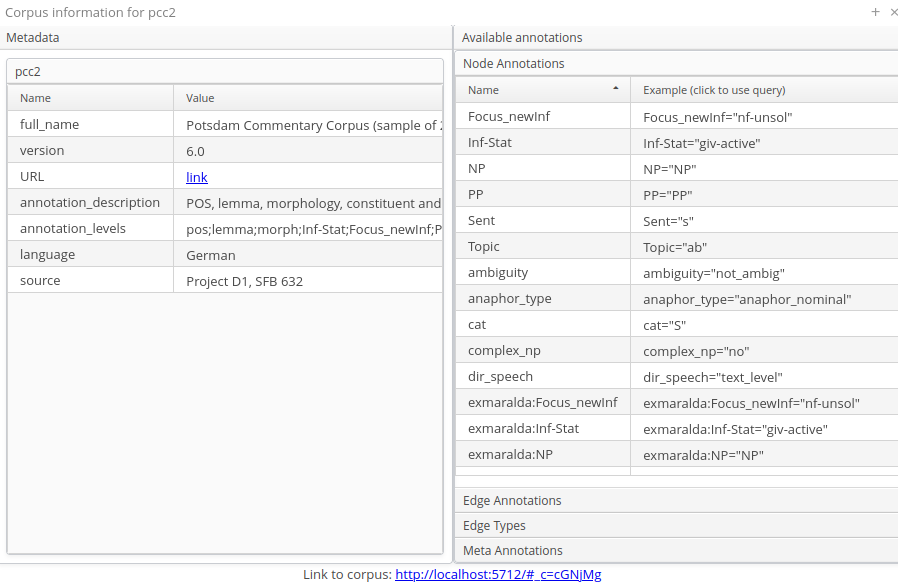Configuring Settings for a Corpus
For each imported corpus, there is a sub-folder in the corpus data folder (per default ~/.annis/v4/) with the corpus name as folder name.
In addition to the actual annotations, this corpus folder contains a configuration file named corpus-config.toml with all corpus specific configuration.1
The configuration file is in the human-readable and editable TOML format and can be edited in any text editor.
TOML uses so-called tables to specify sub-sections of the configuration.
Inside each table, normal key value pairs like in the Java Properties file format can be used.
E.g. the following configuration file has the tables/sections [context] and [view]
[context]
# The default context in the user interface
default = 5
# Available context sizes
sizes = [1, 2, 5, 10]
# Maximal context size in tokens
max = 50
[view]
page_size = 10
Maximal Context Size, Context Steps and Result Page Sizes
The maximal context size of ±n tokens from each search result (for the KWIC view,
but also for other visualizations) can be set for a corpus using the max key in the [context] table.
To configure which steps are actually shown in the front-end (up to the maximum
allowed) add the key sizes and use an array as value.
By default, the context steps 1, 2, 5 or 10 tokens are available.
The default context selected when the corpus is queried, can be set with the default key.
Setting Default Context and Segmentations
In corpora with multiple segmentations, such as historical corpora with conflicting
diplomatic and normalized word form layers, it is possible to choose the default
segmentation for both search context and the KWIC visualization. To set the relevant
segmentations, use the following settings in the corpus-config.toml file.
[context]
# The default segmentation used to generate the context
segmentation="SEGNAME"
[view]
# The default segmentation to show in the user interface (e.g. the KWIC)
base_text_segmentation="SEGNAME"
For more details on segmentations, see the ANNIS Multiple Segmentation Corpora Guide.
Order of metadata annotations
In some views, like the corpus information window (accessible by clicking on the
info icon in the corpus list), metadata annotations are shown. Per default, they
are displayed in alphabetical order. Use the corpus_annotation_order parameter
of the [view] section to explicitly define the order.
[view]
corpus_annotation_order = ["full_name", "version"]
For the pcc2 corpus, this would change display of the metadata in the corpus information view:

All non-mentioned metadata annotations are listed behind the defined ones in alphabetical order.
Adding Example Queries
User created example queries are stored in the file corpus-config.toml as an array of tables.
Each example query starts with the line [[example_queries]] followed by some key value pairs.
[[example_queries]]
query = "\"statisch\""
description = "search for the word \"statisch\""
query_language = "AQL"
[[example_queries]]
query = "/.*lich/"
description = "Search for words ending with \"lich\" (regular expression)"
query_language = "AQL"
[[example_queries]]
query = "\"so\" & \"statisch\" & #1 . #2"
description = "search for the word \"so\" followed by the word \"statisch\""
query_language = "AQL"
Handling of virtual tokens
Corpora with multiple segmentation layers often have "virtual tokens" layer with empty tokens. These virtual tokens are used to align all different spans (including the segmentations) and represent points of time in a timeline. The problem with this data model is, that other span annotations are in theory connected to one of the segmentation layers, but practically only directly connected to the virtual tokens. There is no special relationship between the segmentation spans and other types of spans. This is problematic e.g. when using an exporter, which will use the empty virtual tokens to create the spanned text of a span annotation instead of the correct segmentation layer.
Legacy relANNIS corpora had the virtual_tokenization_mapping and
virtual_tokenization_from_namespace properties in the corpus configuration
(ExtData/corpus.properties file) to explicitly define these relationships.
When importing a relANNIS corpus, these properties will be translated into the
new view.timeline_strategy key in the corpus-config.toml file.
Set the strategy sub-key to the value ImplicitFromNamespace to configure that
non-segmentation span annotations are always referring to the segmentation layer
with the same name as the namespace.
[view.timeline_strategy]
strategy = "ImplicitFromNamespace"
E.g., an annotation instructee:pos would refer to the segmentation layer
instructee.
An explicit mapping between the fully qualified annotation name and the
segmentation layer it refers to can be configured by setting strategy to the
value ImplicitFromMapping and define the mappings in the key
view.timeline_strategy.mappings. In the example, the annotations pos and
lemma are defined to refer to the normalized segmentation norm and the
quote annotation spans refer to the diplomatic transcription dipl.
[view.timeline_strategy]
strategy = "ImplicitFromMapping"
[view.timeline_strategy.mappings]
"lexical::pos" = "norm"
"lexical::lemma" = "norm"
"graphical::quote " = "dipl"
In ANNIS 3 the corpus specific configuration was distributed over several configuration files (e.g. the corpus.properties file) and database tables (like the resolver_vis_map.annis or example_queries.annis files).
When importing an relANNIS corpus, the previous corpus configuration files will be mapped to the new format automatically.